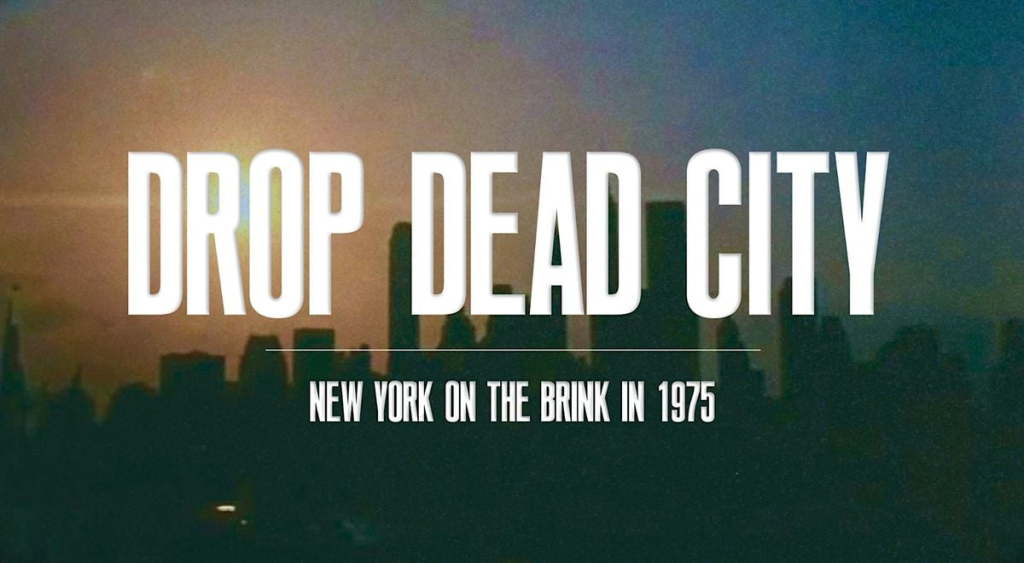“Drop Dead City” is an illuminating documentary that delves deep into the economic turmoil faced by New York City during the tumultuous 1970s fiscal crisis. Through a detailed examination of the city’s near-bankruptcy in 1975, this film highlights the critical lessons of government responsibility and the political creativity that emerged in times of crisis. By bringing forth the complexities of poor fiscal management and the social ideals that contributed to this disaster, “Drop Dead City” serves as a crucial historical narrative that resonates with contemporary issues facing urban governance. The documentary not only recounts the political maneuvers during this period but also critically reflects on the history of liberal government and its impact on urban development. As viewers navigate the stories of those who lived through this era, they are left to contemplate the broader implications of accountability and civic duty in shaping the future of our cities.
Exploring the depths of New York City’s financial upheaval, the documentary entitled “Drop Dead City” sheds light on the crucial events that led to the city’s bankruptcy crisis in the mid-1970s. This captivating film serves as a powerful portrayal of the historical shifts in governance and the varying degrees of political innovation that emerge during economic distress. By examining the intricate narratives behind the 1970s fiscal dilemma, the documentary invites viewers to reflect on the consequences of past decisions and the sometimes hidden challenges of urban administration. Highlighting the critical roles played by city officials and community leaders, it provides a nuanced perspective on the continual struggle for effective governance amidst socio-economic turmoil. As it weaves together personal testimonials and historical analysis, this film underscores the enduring relevance of governmental accountability in shaping urban resilience.
Exploring the 1970s Fiscal Crisis in New York City
The documentary “Drop Dead City” provides a critical lens on the 1970s fiscal crisis that gripped New York City, illuminating the profound economic and social challenges that the city faced. During this time, New York was embroiled in an unprecedented financial emergency, with massive debts outstripping the city’s revenue. The film meticulously chronicles the mismanagement and economic downturn that pushed the city to the brink of bankruptcy, highlighting the complexities of urban governance in a fiscal storm.
In examining the root causes of this crisis, the documentary reveals the intersection of poor managerial decisions and broader economic trends that impacted the city. From the audits that exposed the true scope of financial disarray to the political dynamics that stifled decisive action, “Drop Dead City” captures the turmoil of a transformative era. Through detailed interviews and archival footage, the film paints a vivid picture of the voters’ expectations and the consequences of political creativity in crises.
Political Creativity and Its Consequences in Urban Governance
“Drop Dead City” delves into the concept of political creativity as a double-edged sword during New York’s fiscal crisis. The documentary showcases how, in desperate times, leaders had to engage in innovative strategies to navigate through the financial maelstrom, such as introducing the Municipal Assistance Corporation (MAC). However, it also highlights the consequences of these actions, which often led to painful austerity measures and long-term changes in the city’s governance.
The filmmakers present a nuanced analysis of the role of creativity in addressing urban crises, suggesting that while such ingenuity was essential for immediate survival, it often came at the expense of deeper structural reforms. As the documentary unfolds, it questions whether the temporary fixes provided during the 1970s ultimately hindered a more holistic approach to governance, leading to ongoing challenges that continue to affect New Yorkers today.
The Role of Government Responsibility in Crisis Management
At its core, “Drop Dead City” serves as a reflection on the responsibilities of government during times of economic distress. The film scrutinizes the liberal ideals that shaped policies but also led to missteps that exacerbated the fiscal crisis. Through the lens of history, it argues that government must balance its social ideals with fiscal reality, a lesson that resonates deeply in contemporary discussions about public administration.
By examining the historical context of New York City’s crisis, the documentary invites viewers to consider who holds responsibility for such failures. It emphasizes the importance of accountability in government, especially during crises when the stakes are particularly high. This emphasis on government responsibility serves as a critical takeaway, urging new generations of leaders to learn from the past and approach financial management with transparency and foresight.
Chronicling the Legacy of Liberal Government
The documentary “Drop Dead City” not only recounts the details of the fiscal crisis but also engages with the broader legacy of liberal government in New York City. By contextualizing the 1970s crisis within the framework of past liberal policies, the film critiques the ideals that, while well-intentioned, contributed to unsustainable pressures on the city’s budget. This rich historical narrative prompts a discussion about the evolution of governance and the unintended consequences of liberal policies.
As viewers are taken through the narratives of various stakeholders from the time, the poignant reflections on governance provoke a necessary dialogue about the challenges faced by urban leadership. The film underscores the idea that understanding past mistakes is essential in cultivating a more resilient urban framework for future generations, highlighting the need for continued innovation in the face of adversity.
Racial Inequalities and the Fiscal Crisis
While “Drop Dead City” excels in chronicling the economic turmoil of the 1970s, it also subtly highlights a significant omission: the impact of racial inequalities on the fiscal crisis. The documentary leads viewers to ponder how issues of racial segregation and economic decline affected communities of color during this turbulent period. By addressing the systemic challenges faced by marginalized groups, the film can deepen its critique of the political decisions made at the time.
This exploration invites a broader understanding of the crisis, urging viewers to consider the intersections of race, economics, and governance. As the film presents the narratives of city leaders and residents alike, it encourages a more inclusive dialogue about the legacies of past governance and invites discussions about equity and representation in contemporary political structures.
The Impact of Federal Involvement in New York’s Recovery
“Drop Dead City” closely examines the role of federal assistance in New York City’s recovery from its fiscal crisis, illustrating how the government’s interventions were critical for survival. The film details President Gerald Ford’s hesitant approach to bailout discussions, revealing the complexities of federal-state dynamics during a financial emergency. The contentious politics surrounding federal aid underscore the broader themes of power and responsibility in crisis situations.
The aftermath of federal involvement reshaped the city’s governance, leading to profound changes in its financial landscape. By chronicling these developments, the documentary suggests that while federal assistance provided a lifeline, it imposed restrictions that led to long-term implications for how city budgets are managed. This lesson echoes in contemporary debates about the role of federal aid in urban recovery efforts, making the film’s insights timeless and relevant.
Local Leadership and its Role in Crisis Resolution
As showcased in “Drop Dead City,” local leadership played a crucial role in navigating the crisis that plagued New York City during the 1970s. The film pays particular attention to key figures like Mayor Abraham Beame and his successor Harrison Goldin, illuminating their efforts to confront the city’s dire financial situation. Beame’s early miscalculations and Goldin’s subsequent audits became pivotal moments that shaped the city’s approach to recovery.
Through engaging storytelling, the documentary highlights the importance of informed local leadership in times of crisis. It stresses that effective governance requires not only a grasp of fiscal realities but also a willingness to embrace difficult decisions that may provoke public dissent. This narrative serves as an important reminder for contemporary policymakers about the necessity of strong leadership during challenging times.
The Social Ideals Behind the Crisis
At the heart of “Drop Dead City” lies a critical exploration of the social ideals that contributed to New York City’s fiscal crisis. The documentary probes the interplay between liberal governance and the realities of urban management, questioning the philosophical underpinnings of policies that led to financial instability. This examination sheds light on how well-meaning initiatives can occasionally result in unforeseen consequences, contributing to broader debates on policy formulation.
By addressing these social ideals, the film encourages viewers to critique the legacy of urban governance through a new lens. It suggests that understanding the ideological motivations behind financial decisions can lead to more informed strategies in shaping future urban policy, thereby fostering a more sustainable environment for successive generations.
Contemporary Reflections from a Historical Crisis Perspective
“Drop Dead City” serves not only as a historical recount but also as a pertinent reflection on contemporary urban challenges. By connecting the struggles of the 1970s with modern-day issues, the documentary emphasizes the cyclical nature of fiscal crises and governmental response. The film inspires contemporary audiences to learn from the past as they navigate their own economic uncertainties.
Through the lens of history, viewers are invited to engage with the philosophical implications of governance and responsibility, propelling a conversation about how cities can better prepare for potential crises. The lessons gleaned from the film resonate beyond New York, offering insights applicable to urban centers across the globe, reinforcing the idea that past governance failures can inform future resilience strategies.
Frequently Asked Questions
What is the main focus of the Drop Dead City documentary?
The Drop Dead City documentary primarily focuses on the historical context of New York City’s fiscal crisis in the 1970s, detailing the economic changes and managerial errors that led the city to the brink of bankruptcy.
How does Drop Dead City explore the 1970s fiscal crisis?
In Drop Dead City, the filmmakers meticulously reconstruct the 1970s fiscal crisis by examining its causes, effects, and the governmental responses, showcasing the political creativity in crises that ultimately shaped the city’s financial recovery.
Who directed the Drop Dead City documentary?
The documentary Drop Dead City is directed by Peter Yost and Michael Rohatyn, who utilize their extensive experience in historical filmmaking to tell this complex story.
What historical events does Drop Dead City highlight?
Drop Dead City highlights key historical events from the 1970s, particularly the challenges faced by New York City as it grappled with a massive financial crisis, culminating in the famous ‘DROP DEAD’ statement by President Gerald Ford.
What themes are explored in Drop Dead City in relation to liberal government?
The themes explored in Drop Dead City relate to the history of liberal government, illustrating how social ideals and political decisions contributed to the fiscal crisis, as well as the responsibility of government during such crises.
Does Drop Dead City address issues of racial inequality?
While Drop Dead City provides insights into the fiscal crisis, it has been noted that the documentary glosses over important issues of racial inequality and the effects of economic decline on communities of color during that period.
What was the impact of Gerald Ford’s speech mentioned in Drop Dead City?
Gerald Ford’s speech, which included the notorious ‘DROP DEAD’ remark, significantly impacted public sentiment and political momentum regarding the federal bailout of New York City, leading to a shift in opinions and eventual financial assistance.
Can I find information about government responsibility in the Drop Dead City documentary?
Yes, Drop Dead City delves deeply into the notion of government responsibility, exploring the critical decisions and missteps of leaders during New York City’s fiscal crisis in the 1970s.
How does Drop Dead City reflect on the political creativity in crises?
The documentary Drop Dead City illustrates political creativity in crises by showcasing the various strategies and negotiations employed by city officials in response to financial distress and the eventual restructuring efforts.
What lessons can be learned from the Drop Dead City documentary?
Drop Dead City offers valuable lessons on the importance of transparent governance, fiscal responsibility, and the social implications of political decisions during economic crises, making it a relevant viewing for those interested in government and economics.
| Key Points |
|---|
| Examines New York City’s fiscal crisis of the mid-1970s and its causes, effects, and resolutions. |
| Focuses on the political and social implications of liberal governance during this period. |
| Highlights the confrontation between President Ford and New York City, including the famous ‘DROP DEAD’ headline. |
| Discusses the mismanagement and hidden debt discovered by Mayor Harrison Goldin. |
| Explores the establishment of the Municipal Assistance Corporation (MAC) for financial rescue and its austerity conditions. |
| Concludes with a reflection on the long-term negative changes in the city’s governance and social structure. |
Summary
The “Drop Dead City documentary” serves as a poignant reminder of New York City’s struggle during a critical financial crisis in the 1970s. This documentary not only chronicles the events leading to the near-bankruptcy of a major city but also delves into the intricacies of governance and the socio-political landscape of the time. By examining the historical mismanagement and the subsequent political fallout, this film sheds light on the complexities that were at play, all while highlighting the lasting impacts of those decisions on urban life today. An insightful exploration of liberal governance, it encourages viewers to reflect on the mistakes of the past and the lessons that must be learned.



